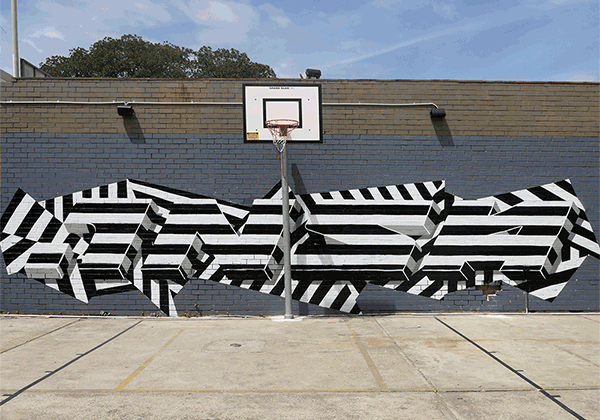
INSA’s GIF-iti in Sydney, Australia. Animation by INSA.
To briefly bring back just one example from chapter 2, INSA’s animated GIFs, his GIF-iti, are fantastic examples of a graffiti writer intentionally making organic viral art for the web. While each one does exist on a wall somewhere and is still (legal) graffiti in the more traditional sense, INSA fully intends for those pieces to be viewed online as animations rather than or in addition to an away-from-keyboard experience. He’s explained that he is trying to make something that will stand out not on a wall against a dozen other pieces of graffiti, but on Tumblr against thousands of other photos, illustrations and animations of just about anything. GIF-iti is a prime example of organic viral art.
Recall that Rebecca Rosen, the author of an article on GIF-iti for The Atlantic Cities, referred to the GIF-iti as “public Internet art. That’s another great phrase for viral art, particularly organic viral art since it’s not imposed upon you and so is in that sense more closely related to public art than to street art or graffiti. Organic viral art is public art (although not usually in the sense of having been commissioned), but it exists on the internet. But if INSA’s GIFs are public internet art, then isn’t a GIF by General Howe also public internet art? Once both GIFs are up against one another on Tumblr, it hardly matters that INSA painted a wall somewhere to make his GIF-iti and General Howe made his animation entirely in Photoshop any more that it matters if a piece of street art is made by handpainting a poster or spraypainting a stencil. You may prefer over the other, but at their core the GIFs are artworks next to one another on Tumblr just as the works of street art are artworks next to one another on a wall. Once we’re at the GIF-iti stage, why continue to differentiate between INSA’s GIF-iti and what any other GIF artist does? It’s all organic viral art or, to put it another way, public internet art.
It frustrates me when street artists and graffiti writers say that things have to be done a certain way. If the goal of graffiti is fame (and in reality that may be just one goal among many that various writers prioritize differently), any way that a writer gets that fame should be considered legitimate. Once writers start putting in rules, like that graffiti can’t be done with wheatpastes, it distracts from the end goal. I use graffiti as an example because it’s a bit more obvious where those rules come into play, but the same thing could be said about street art. Too many street artists and graffiti writers get bogged down in rules and tools like needing to write a name or using stencils, losing sight of the end goal of unmediated distribution from artist to public. It’s the writers and street artists who use the web like they use walls that aren’t getting bogged down in these rules and are keeping focused on achieving their end goal in the most effective way possible.